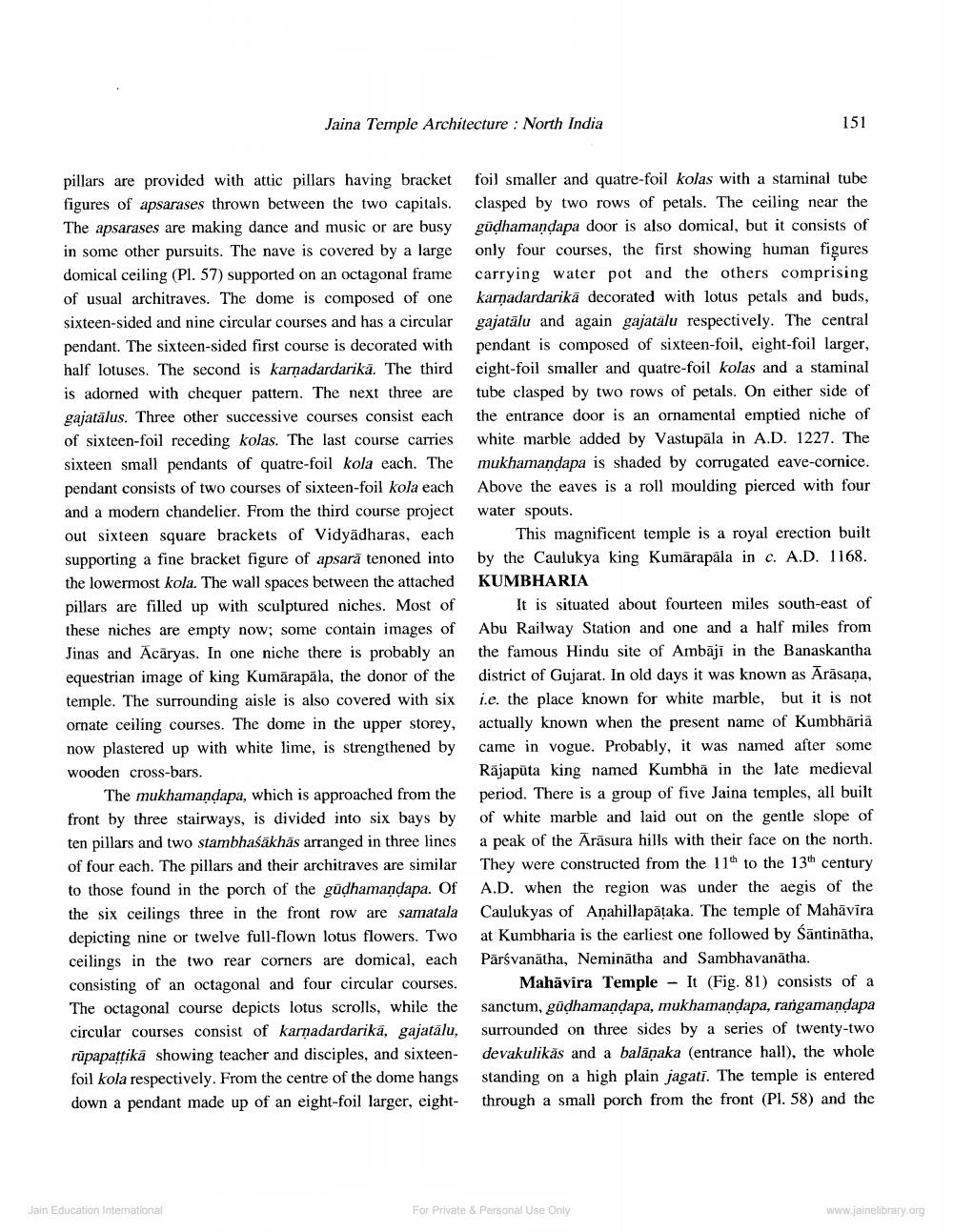________________
Jaina Temple Architecture : North India
151
pillars are provided with attic pillars having bracket figures of apsarases thrown between the two capitals. The apsarases are making dance and music or are busy in some other pursuits. The nave is covered by a large domical ceiling (Pl. 57) supported on an octagonal frame of usual architraves. The dome is composed of one sixteen-sided and nine circular courses and has a circular pendant. The sixteen-sided first course is decorated with half lotuses. The second is karņadardarikā. The third is adorned with chequer pattern. The next three are gajatālus. Three other successive courses consist each of sixteen-foil receding kolas. The last course carries sixteen small pendants of quatre-foil kola each. The pendant consists of two courses of sixteen-foil kola each and a modern chandelier. From the third course project out sixteen square brackets of Vidyādharas, each supporting a fine bracket figure of apsara tenoned into the lowermost kola. The wall spaces between the attached pillars are filled up with sculptured niches. Most of these niches are empty now; some contain images of Jinas and Acäryas. In one niche there is probably an equestrian image of king Kumārapāla, the donor of the temple. The surrounding aisle is also covered with six ornate ceiling courses. The dome in the upper storey, now plastered up with white lime, is strengthened by wooden cross-bars.
The mukhamandapa, which is approached from the front by three stairways, is divided into six bays by ten pillars and two stambhaskhas arranged in three lines of four each. The pillars and their architraves are similar to those found in the porch of the gūdhamandapa. Of the six ceilings three in the front row are samatala depicting nine or twelve full-flown lotus flowers. Two ceilings in the two rear corners are domical, each consisting of an octagonal and four circular courses. The octagonal course depicts lotus scrolls, while the circular courses consist of karnadardarika, gajatālu, rūpapatřikā showing teacher and disciples, and sixteenfoil kola respectively. From the centre of the dome hangs down a pendant made up of an eight-foil larger, eight-
foil smaller and quatre-foil kolas with a staminal tube clasped by two rows of petals. The ceiling near the gūdhamandapa door is also domical, but it consists of only four courses, the first showing human figures carrying water pot and the others comprising karņadardarikā decorated with lotus petals and buds, gajatālu and again gajatalu respectively. The central pendant is composed of sixteen-foil, eight-foil larger, eight-foil smaller and quatre-foil kolas and a staminal tube clasped by two rows of petals. On either side of the entrance door is an ornamental emptied niche of white marble added by Vastupāla in A.D. 1227. The mukhamandapa is shaded by corrugated eave-cornice. Above the eaves is a roll moulding pierced with four water spouts.
This magnificent temple is a royal erection built by the Caulukya king Kumärapåla in c. A.D. 1168. KUMBHARIA
It is situated about fourteen miles south-east of Abu Railway Station and one and a half miles from the famous Hindu site of Ambaji in the Banaskantha district of Gujarat. In old days it was known as Ārāsana, i.e. the place known for white marble, but it is not actually known when the present name of Kumbhāriā came in vogue. Probably, it was named after some Rajaputa king named Kumbha in the late medieval period. There is a group of five Jaina temples, all built of white marble and laid out on the gentle slope of a peak of the Aräsura hills with their face on the north. They were constructed from the 11th to the 13th century A.D. when the region was under the aegis of the Caulukyas of Anahillapātaka. The temple of Mahāvira at Kumbharia is the earliest one followed by Sāntinātha, Pärsvanātha, Neminātha and Sambhavanātha.
Mahāvira Temple - It (Fig. 81) consists of a sanctum, gūdhamandapa, mukhamandapa, rangamandapa surrounded on three sides by a series of twenty-two devakulikäs and a balāņaka (entrance hall), the whole standing on a high plain jagati. The temple is entered through a small porch from the front (Pl. 58) and the
Jain Education Intemational
For Private & Personal Use Only
www.jainelibrary.org




